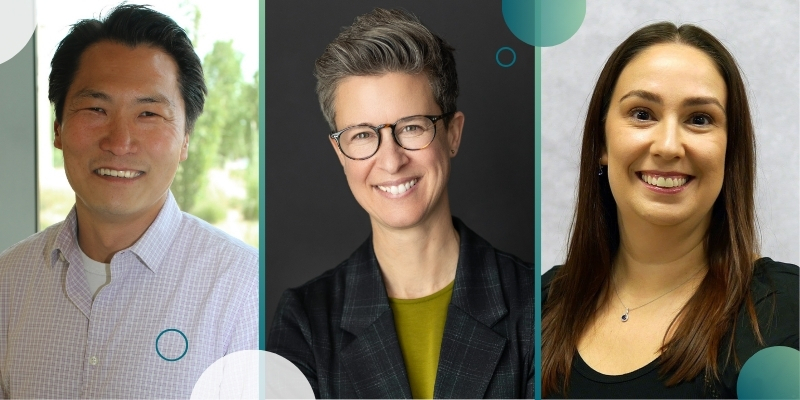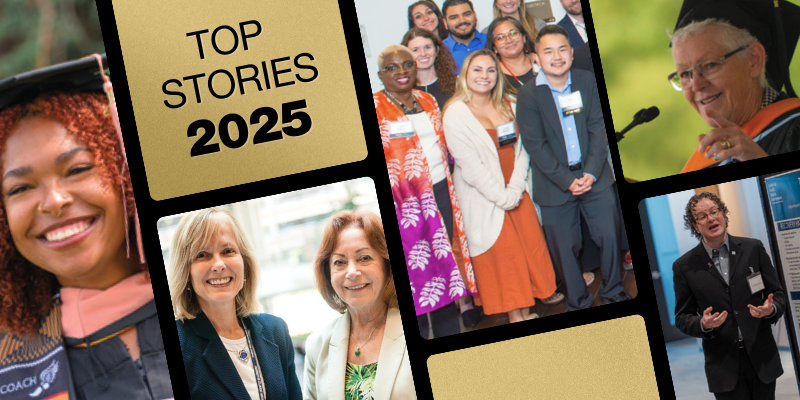Despite its date, the fifth annual Colorado School of Public Health PHired Up Alumni Talks were far from taxing for the attendees at Tamayo restaurant in downtown Denver April 15. The event, put on by ColoradoSPH and the CU Anschutz Office of Alumni Relations, featured short talks by alumni about public health issues they have encountered in their work. ColoradoSPH Professor and Dean Dr. Cathy Bradley also updated attendees about new developments at the school.
Three alumni who delivered PHired Up talks spoke about their backgrounds and the information they shared with their colleagues.
Adam Anderson
Adam Anderson’s early professional background in architecture and urban planning didn’t seem to foretell a career in public health. But he found common ground between the two in the old real estate maxim that the future of communities depends on three words: location, location, location.
Assisting private developers and government as a land planner across the United States, Anderson designed parks and open space as part of his work. He says that over time, the activity got him interested in how the broader built environment affects people’s interactions and their health. Think the proximity of residential to industrial areas, he said.
His interests ultimately led him to pursue and earn two degrees in parallel: a Master of Urban Planning and Development from the University of Colorado Denver and a Master of Public Health (MPH) from Colorado School of Public Health in 2013.
During his MPH work at ColoradoSPH, Anderson retained his interest in quantifying how the design of communities affects people’s social interactions and their health, but he also realized there wasn’t much available data to draw on. In response, his coursework leaned heavily to data classes.
During his MPH studies, he created, on how own, a project that looked at the relation of zoning and land use to life expectancy. He found that the strongest correlation was with right-of-way: the land dedicated to infrastructure, including transportation, utilities, and other public structures.
“If you have bigger highways going through your neighborhood, the services that are provided are not geared toward residential uses,” Anderson said. Less desirable neighborhoods with fewer services “are not as conducive to a healthy environment or healthy place to live,” he concluded.
That self-starter work, with the assistance of his ColoradoSPH advisors, helped land Anderson a position with the Colorado Department of Health and Environment (CDPHE). During his time with CDPHE and later the Tri-County Health Department, Anderson worked with Geographic Information System (GIS) mapping – a staple tool of urban planning – to improve his understanding of the physical and social characteristics of communities around the state.
He continues to rely on GIS in his present position as Director of Epidemiology and Data Science for Adams County.
“The prevailing ethos for every project that my data team works on is to identify the disparities and the characteristics of the communities that are experiencing those disparities,” Anderson said. For example, he noted, parts of Adams County have a heavy concentration of industry, including refineries, asphalt plants, and trash incineration, with effects not shared by other communities.
“Looking at those environmental issues is obviously inherent with geography and proximity to those things,” he said.
Looking forward, Anderson said he and his team are working to build “data portals” for Adams County staff that integrate previously siloed health information. The idea is to provide an accessible range of information that drives policy decisions, from individual diseases to environmental conditions, he noted.
Anderson shared some details of this work in his PHired Up talk, which aimed to highlight innovation, data, and technology in public health.
“I think what we are doing with this integrated data system is pretty innovative, relative to what I’ve seen in local public health in general,” he said. “It’s a mechanism to modernize our local public health data infrastructure.”
Molly Gutilla
When Dr. Molly Gutilla became part of the first admitted class of the Doctor of Public Health (DrPH) program at Colorado School of Public Health in 2010, she wasn’t aware of the term “artificial intelligence,” much less the effect it might have on her career.
Gutilla was focused on shifting her academic focus from exercise physiology – she had earned undergraduate and master’s degrees in that field at Ohio State University – to epidemiology, a field she stumbled on in taking a few public health courses out of curiosity.
“The first time I took an epidemiology class, I realized that the science is a hybrid. It’s a natural science and a social science,” Gutilla said. “It can provide so much opportunity with the skill set that you develop.”
That insight, coupled with a desire to live in Colorado and a love for “change and adventure,” led her to ColoradoSPH and the DrPH degree she completed in 2017.
In the eight years since graduating, Gutilla has taken on a heavy teaching load as an associate professor in Epidemiology at ColoradoSPH’s Colorado State University campus.
“I absolutely love being a teacher, being in a classroom with students,” Gutilla said. In an era of informational transformation spurred by artificial intelligence (AI), teaching offers both satisfaction and challenge, she added.
“As our world and technology change, the classroom is an experiment to observe that and figure it out.”
Gutilla sees AI as a major factor reshaping the experience that her students bring to the classroom. She compares it to another technological disruptor a few decades back.
“I imagine some math teacher had a moment where they put a calculator in their hand for the first time and then thought, ‘Whoa, what does this mean to my job, and what am I doing?’ I feel with AI, I am also having that moment. It’s coming into my daily life, ready or not.”
The flashpoint for that realization came about a year ago, Gutilla said. A student with whom she had built a strong relationship sent her an email that “felt really disproportionate to our human relationship,” she recalled.
The problem was the tone, which was too formal and carefully crafted. It sounded not at all like the student she knew, Gutilla said. The student readily acknowledged she had used AI to write the email to save time. Gutilla responded that it didn’t feel good to receive the robotic-sounding email but she understood why the student would use it.
The conversation that followed was productive, and “a catalyst moment” for Gutilla, who used it as an opportunity to develop a narrative for her PHired Up talk about AI and its effects on her teaching.
“What I think about is the actual speed of learning sometimes is a lot slower than putting a prompt into ChatGPT,” Gutilla said. “I’m not saying there is no room for ChatGPT. I’m distinguishing where and when and how to use it, and the potential gain and benefit, and what you might lose from fast-forwarding to artificial speed.”
Helping students find that balance is a work in progress, Gutilla acknowledged. She uses AI as a “consultant” that helps her with tasks like tweaking homework assignment instructions, but she does not use it to assess student understanding or to assist with grading.
“I wouldn’t say I have it figured out and have best practices for teaching, but I am in the practice of thinking and learning,” she said.
Gutilla said she relished the opportunity to attend the PHired Up event and deliver her talk, while also reconnecting with classmates who have pursued different career paths.
“It fills up my enthusiasm tank,” she said. “Being with fellow alumni again in new and different challenging times brings me comfort.”
Lucía Sanders
After earning her Master of Public Health from ColoradoSPH in 2015, Lucía Sanders entered the tech world of public health, which she calls “a perfect fit for me.” But while she has built a data-driven career, a community-immersed pilot project cemented her commitment to public health.
For her capstone project in Environmental and Occupational Health, Sanders worked with Denver Environmental Health (now the Denver Department of Public Health & Environment) on the Healthy Corner Store initiative – an effort to bring healthy food options to Denver neighborhoods with high food insecurity. She developed and conducted surveys to help determine if the pilot would be successful if it were expanded further – which it ultimately was.
She saw that collecting the data that could demonstrate the value of a project in improving people’s lives was essential.
“It confirmed that public health was where I wanted to be,” Sanders said.
In her final year at ColoradoSPH, Sanders began an eight-year stint with Envision Technology Partners, which tracks immunizations for state and local health departments and provides clinical decision support for health care providers helping their patients stay on schedule with their shots. The work again allowed her to link her affinity for data with the real-world challenges of public health.
Today, Sanders serves as key account manager for the Center for Improving Value in Health Care (CIVHC), which administers Colorado’s All Payer Claims Database, a vital source of information about health care delivery.
“I partner with anyone who is interested in requesting data to use for a project that will benefit the residents of Colorado,” Sanders said. One recent example: social factors, such as income, education, employment, housing/transportation, and race/ethnicity/language), were strongly related to higher numbers of potentially preventable emergency department visits.
Such data could help policymakers determine costs and benefits of changes in the health care system that affect large patient populations, Sanders said.
She added that tools on the CIVHC website can help consumers. For example, a “Shop for Care” tool helps people compare average costs of care for a variety of planned-in-advance procedures and services at hospitals and clinics.
“You can weigh the cost of the procedure, the quality ranking of the facility, and the distance to the facility [from your Zip Code],” Sanders said.
She noted other examples of underappreciated data sources that are available to the public. For example, the Colorado Department of Public Health and Environment’s Immunization Information System allows individuals to look up their own and their children’s immunization records and generate official records of their shot histories.
“It’s another really easy tool that I don’t know that many people know about,” Sanders said.
She shared her insights about the value of big data during her PHired Up talk. She said she valued hearing from and connecting with her colleagues in public health.
“It’s fun and it’s educational to see what else is going on,” Sanders said. “I was excited to share with everyone resources that are freely available to everybody. I hope that they go home and talk to their family and friends about it.”
At the end of her talk, she shared some QR codes so that people could access the sites and learn more. She said she saw a lot of phones go up in the air to snap the information.
“My very informal experiment was to see how many phones went up,” she said jokingly. “I was pretty happy about that.”





%20(2).png)
